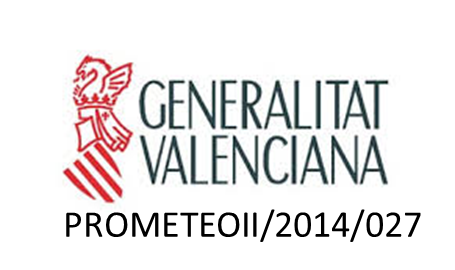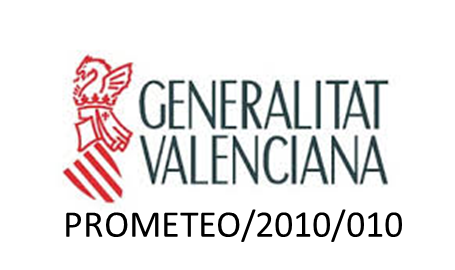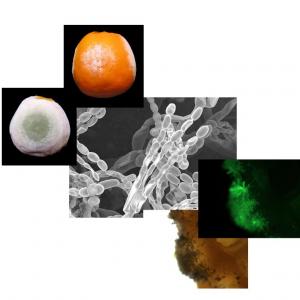
Biografía
La mayor parte de mi trabajo científico se puede agrupar en dos grandes líneas temáticas: Biotecnología de microorganismos de interés agroalimentario y fitopatología. La primera línea la inicié durante mi Tesis Doctoral, que se centró en la clonación y caracterización de dos genes de Bacillus polymyxa que codifican ß-glucosidasas. Este trabajo se enmarcaba dentro de una línea encaminada a la producción de enzimas degradadoras de la pared celular vegetal. El interés en estas enzimas me llevó a interesarme por la fitopatología. Así, el tema de trabajo durante mi estancia postdoctoral fue el estudio molecular de las pectato liasas de Fusarium solani y su posible papel como factores de patogenicidad. Durante mi etapa de reincorporación como doctor contratado en el IATA proseguí los trabajos encaminados a la utilización de proteínas microbianas con potencial interés agroalimentario mediante clonación y caracterización del gen/es correspondiente/s y producción heteróloga en cepas industriales de Saccharomyces cerevisiae o en hongos filamentosos. En la mayoría de los casos trabajé con genes/enzimas relacionadas con la degradación de la pared celular vegetal. Una vez me incorporé al grupo de Postcosecha del IATA la mayor parte de mi trabajo se ha centrado en el estudio de la interacción fruto-patógeno. Desde el punto de vista del fruto he trabajado en la caracterización bioquímica, molecular, metabolómica y genómica de las respuestas de defensa y la inducción de resistencia de frutos de manzana y cítricos a sus principales patógenos, (Penicillium expansum y Penicillium digitatum, respectivamente). En los distintos estudios realizados destaca el metabolismo secundario de frutos como uno de los factores clave en la respuesta de defensa de los frutos a la infección. Desde el punto de vista del patógeno el grupo que dirijo ha desarrollado un juego completo de herramientas que nos permiten diseccionar los factores de patogenicidad y virulencia de los principales hongos del género Penicillium patógenos de frutos. Entre estos factores caben destacar varios grandes grupos de genes relacionados con proteólisis, metabolismo redox, degradación de pared celular vegetal, metabolismo secundario o efectores. La caracterización funcional de estos genes constituye actualmente una de las líneas de trabajo más activas. Un aspecto distintivo de los estudios de fitopatología postcosecha llevados a cabo es la utilización de aproximaciones “ómicas”, como el análisis metabolómico por HPLC-MS, la utilización de aproximaciones transcriptómicas, incluyendo microarrays de cDNA, genotecas substractivas o el empleo de RNA-Seq para identificar genes inducidos/reprimidos durante la interacción hongo-fruto en ambos patosistemas. En este sentido es de destacar que hemos sido pioneros en la secuenciación de genomas de varios hongos patógenos postcosecha del género Penicillium. Una parte del trabajo tiene una visión más aplicada, ya que se centra en la búsqueda y desarrollo de métodos alternativos a la utilización de fungicidas químicos. Una línea paralela es la caracterización molecular de genes de Aspergillus carbonarius implicados en la síntesis de la micotoxina OTA.
Proyectos











Publicaciones
Sánchez-Torres, P., González-Candelas, L., Ballester, A.R., 2024. Discovery and Transcriptional Profiling of Penicillium digitatum Genes That Could Promote Fungal Virulence during Citrus Fruit Infection. Journal of Fungi 10, 235. https://doi.org/10.3390/jof10040235
Llobregat, B., González-Candelas, L., Ballester, A.-R., 2024. Exploring the Biocontrol Capability of Non-Mycotoxigenic Strains of Penicillium expansum. Toxins 16, 52. https://doi.org/10.3390/toxins16010052
Lafuente, M.T., González-Candelas, L., 2024. Phytohormones in the Penicillium digitatum-citrus fruit interaction. Postharvest Biology and Technology 209, 112704. https://doi.org/10.1016/j.postharvbio.2023.112704
Lafuente, M.T., González-Candelas, L., 2022. The Role of ABA in the Interaction between Citrus Fruit and Penicillium digitatum. International Journal of Molecular Sciences 23, 15796. https://doi.org/10.3390/ijms232415796
Llobregat, B.; González-Candelas, L.; Ballester, A.-R. 2022. Ochratoxin A defective Aspergillus carbonarius mutants as potential biocontrol agents. Toxins, 14, 745. https://doi.org/10.3390/toxins14110745
Delgado, J.; Ballester, A.-R.; González-Candelas, L.; Núñez, F. 2022. Impact of the antifungal Protein PgAFP on the proteome and patulin production of Penicillium expansum on apple-based medium. International Journal of Food Microbiology, 363, 109511. https://doi.org/10.1016/j.ijfoodmicro.2021.109511
Lafuente, M.T.; Romero, P.; González-Candelas, L.. 2021. Albedo- and Flavedo-Specific Transcriptome Profiling Related to Penicillium digitatum Infection in Citrus Fruit. Foods 10, 2196. https://doi.org/10.3390/foods10092196
Gerin, D.; Garrapa, F.; Ballester, A.-R.; González-Candelas, L.; De Miccolis Angelini, R.M.; Faretra, F.; Pollastro, S. 2021. Functional Role of Aspergillus Carbonarius AcOTAbZIP Gene, a BZIP Transcription Factor within the OTA Gene Cluster. Toxins 13, 111. https://doi.org/10.3390/toxins13020111
Ballester, A.-R., González-Candelas*, L., 2020. EFE-Mediated Ethylene Synthesis Is the Major Pathway in the Citrus Postharvest Pathogen Penicillium digitatum during Fruit Infection. Journal of Fungi 6, 175. https://doi.org/10.3390/jof6030175
González-Candelas*, L., Ballester, A.-R., 2020. Molecular insights into the pathogenicity of necrotrophic fungi causing postharvest disesases, in: Palou, L., Smilanick, J.L. (Eds.), Postharvest Pathology of Fresh Horticultural Produce. CRC Press Taylor & Francis Group, Boca Raton, pp. 375–406. https://doi.org/10.1201/9781315209180-11
Valente, S., Cometto, A., Piombo, E., Meloni, G.R., Ballester, A.-R., González-Candelas*, L., Spadaro*, D., 2020. Elaborated regulation of griseofulvin biosynthesis in Penicillium griseofulvum and its role on conidiation and virulence. International Journal of Food Microbiology 328, 108687. https://doi.org/10.1016/j.ijfoodmicro.2020.108687
Díaz Ricci*, J.C., González-Candelas, L., Prusky, D.B., Moser, C., Baraldi, E., 2020. Editorial: Interplay Between Fungal Pathogens and Fruit Ripening. Front. Plant Sci. 11. 275. https://doi.org/10.3389/fpls.2020.00275
de Ramón-Carbonell, M., López-Pérez, M., González-Candelas, L., Sánchez-Torres*, P., 2019. PdMFS1 Transporter Contributes to Penicilliun digitatum Fungicide Resistance and Fungal Virulence during Citrus Fruit Infection. Journal of Fungi 5, 100. https://doi.org/10.3390/jof5040100
Delgado, J., Ballester, A.-R., Núñez*, F., González-Candelas*, L., 2019. Evaluation of the activity of the antifungal PgAFP protein and its producer mould against Penicillium spp postharvest pathogens of citrus and pome fruits. Food Microbiol. 84, 103266. https://doi.org/10.1016/j.fm.2019.103266
Ballester, A.-R., López-Pérez, M., de la Fuente, B., González-Candelas*, L., 2019. Functional and pharmacological analyses of the role of Penicillium digitatum proteases on virulence. Microorganisms 7, 198. https://doi.org/10.3390/microorganisms7070198
Benito-González, I., López-Rubio, A., Martínez-Abad, A., Ballester, A.-R., Falcó, I., González-Candelas, L., Sánchez, G., Lozano-Sánchez, J., Borrás-Linares, I., Segura-Carretero, A., Martínez-Sanz*, M., 2019. In-depth characterization of bioactive extracts from Posidonia oceanica waste biomass. Mar. Drugs 17, 409. https://doi.org/10.3390/md17070409
Levin, E., Raphael, G., Ma, J., Ballester, A.-R., Feygenberg, O., Norelli, J., Aly, R., Gonzalez-Candelas, L., Wisniewski, M., Droby*, S., 2019. Identification and Functional Analysis of NLP-Encoding Genes from the Postharvest Pathogen Penicillium expansum. Microorganisms 7, 175. https://doi.org/10.3390/microorganisms7060175
Lafuente*, M.T., Ballester, A.-R., González-Candelas, L., 2019. Involvement of abscisic acid in the resistance of citrus fruit to Penicillium digitatum infection. Postharvest Biol. Technol. 154, 31-40. https://doi.org/10.1016/j.postharvbio.2019.04.004
Levin, E., Kishore, A., Ballester, A.R., Raphael, G., Feigenberg, O., Liu, Y., Norelli, J., Gonzalez-Candelas, L., Wisniewski, M., Droby*, S., 2019. Identification of pathogenicity-related genes and the role of a subtilisin-related peptidase S8 (PePRT) in authophagy and virulence of Penicillium expansum on apples. Postharvest Biol. Technol. 149, 209-220. https://doi.org/10.1016/j.postharvbio.2018.10.011
Vilanova†, L., López-Pérez†, M., Ballester, A.-R., Teixidó, N., Usall, J., Lara, I., Viñas, I., Torres*, R., González-Candelas*, L., 2018. Differential contribution of the two major polygalacturonases from Penicillium digitatum to virulence towards citrus fruit. Int. J. Food Microbiol. 282, 16-23. https://doi.org/10.1016/j.ijfoodmicro.2018.05.031
Lafuente*, M.T., Alférez, F., González‐Candelas, L., 2018. Light‐emitting Diode Blue Light Alters the Ability of Penicillium digitatum to Infect Citrus Fruits. Photochem. Photobiol. 94, 1003-1009. https://doi.org/10.1111/php.12929
Gerin, D., González-Candelas, L., Ballester, A.-R., Pollastro*, S., De Miccolis Angelini, R., Faretra, F., 2018. Functional characterization of the alb1 orthologue gene in the ochratoxigenic fungus Aspergillus carbonarius (AC49 strain). Toxins 10, 120. https://doi.org/10.3390/toxins10030120
Sánchez-Torres*, P., Vilanova, L., Ballester, A.R., López-Pérez, M., Teixidó, N., Viñas, I., Usall, J., González-Candelas, L., Torres, R. 2018. Unravelling the contribution of the Penicillium expansum PeSte12 transcription factor to virulence during apple fruit infection. Food Microbiol. 69:123-135. https://doi.org/10.1016/j.fm.2017.08.005
Ballester*, A.-R., Norelli, J., Burchard, E., Abdelfattah, A., Levin, E., González-Candelas, L., Droby, S., Wisniewski*, M., 2017. Transcriptomic Response of Resistant (PI613981–Malus sieversii) and Susceptible (“Royal Gala”) Genotypes of Apple to Blue Mold (Penicillium expansum) Infection. Frontiers in Plant Science 8: 1981. https://doi.org/10.3389/fpls.2017.01981
Levin, E., Ballester, A.R., Raphael, G., Feigenberg, O., Liu, Y., Norelli, J., Gonzalez-Candelas, L., Ma, J., Dardick, C., Wisniewski, M., Droby*, S., 2017. Identification and characterization of LysM effectors in Penicillium expansum. PLOS One 12: e0186023. https://doi.org/10.1371/journal.pone.0186023
Lafuente*, M.T., Establés-Ortiz, B, González-Candelas, L. 2017. Insights into the molecular events that regulate heat-induced chilling tolerance in citrus fruits. Front. Plant Sci. 8:1113. https://doi.org/10.3389/fpls.2017.01113
Tian*, S., Torres, R., Ballester, A.R., Li, B., Vilanova, L., González-Candelas*, L. 2016. Molecular aspects in pathogen-fruit interactions: Virulence and resistance. Postharvest Biol. Technol. 122:11-21. https://doi.org/10.1016/j.postharvbio.2016.04.018
Establés-Ortiz, B., Romero, P., Ballester, A.-R., González-Candelas, L., Lafuente*, M.T. 2016 Inhibiting ethylene perception with 1-methylcyclopropene triggers molecular responses aimed to cope with cell toxicity and increased respiration in citrus fruits. Plant Physiol. Biochem. 103:154-166. https://doi.org/10.1016/j.plaphy.2016.02.036
Crespo-Sempere, A., Selma-Lázaro, C., Palumbo, J.D., González-Candelas, L., Martínez-Culebras*, P.V. 2016. Effect of oxidant stressors and phenolic antioxidants on the ochratoxigenic fungus Aspergillus carbonarius. J. Sci. Food Agric. 96:169-177. https://doi.org/10.1002/jsfa.7077
Banani†, H., Marcet-Houben†, M., Ballester†, A.-R., Abbruscato, P., González-Candelas*, L., Gabaldón*, T., and Spadaro*, D. 2016. Genome sequencing and secondary metabolism of the postharvest pathogen Penicillium griseofulvum. BMC Genomics 17, 19. https://doi.org/10.1186/s12864-015-2347-x
Ballester†, A.-R., Marcet-Houben†, M., Levin, E, Sela N., Selma-Lázaro, C., Carmona, L., Wisniewski, M., Droby, S., González-Candelas*, L., Gabaldón*, T. 2015. Genome, transcriptome, and functional analyses of Penicillium expansum provide new insights into secondary metabolism and pathogenicity. Mol. Plant-Microbe Interact. 28:232-248. https://doi.org/10.1094/MPMI-09-14-0261-FI
López-Pérez, M., Ballester, A.-R., and González-Candelas*, L., 2015. Identification and functional analysis of Penicillium digitatum genes putatively involved in virulence towards citrus fruit. Mol. Plant Pathol. 16:262-275. López-Pérez, M., Ballester, A.-R., González-Candelas, L., 2015. Identification and functional analysis of Penicillium digitatum genes putatively involved in virulence towards citrus fruit. Molecular Plant Pathology 16, 262–275. https://doi.org/10.1111/mpp.12179
Crespo-Sempere, A., Martínez-Culebras, P.V., and González-Candelas*, L., 2014. The loss of the inducible Aspergillus carbonarius MFS transporter MfsA leads to ochratoxin A overproduction. Int. J. Food Microbiol. 181:1-9. https://doi.org/10.1016/j.ijfoodmicro.2014.04.014
Zhang, T., Sun, X., Xu, Q., González Candelas, L., and Li*, H., 2013. The pH signaling transcription factor PacC is required for full virulence in Penicillium digitatum. App. Microbiol. Biotechnol. 97:9087-9098. https://doi.org/10.1007/s00253-013-5129-x
Crespo-Sempere, A., Selma-Lázaro, C., Martínez-Culebras, P.V., and González-Candelas*, L., 2013. Characterization and disruption of the cipC gene in the ochratoxigenic fungus Aspergillus carbonarius. Food Res. Int. 54:697-705. https://doi.org/10.1016/j.foodres.2013.08.008
Vilanova, L., Torres, R., Viñas, I., González-Candelas, L., Usall, J., Fiori, S., Solsona, C., Teixidó*, N., 2013. Wound response in orange as a resistance mechanism against Penicillium digitatum (pathogen) and P. expansum (non-host pathogen). Postharvest Biol. Technol. 78, 113-122. https://doi.org/10.1016/j.postharvbio.2012.12.013
Ballester, A.-R., Teresa Lafuente, M., González-Candelas*, L., 2013. Citrus phenylpropanoids and defence against pathogens. Part II: Gene expression and metabolite accumulation in the response of fruits to Penicillium digitatum infection. Food Chem. 136, 285-291. https://doi.org/10.1016/j.foodchem.2012.08.006
Ballester, A.-R., Lafuente, M.T., de Vos, R.C.H., Bovy, A.G., González-Candelas*, L., 2013. Citrus phenylpropanoids and defence against pathogens. Part I: Metabolic profiling in elicited fruits. Food Chem. 136, 178-185. https://doi.org/10.1016/j.foodchem.2012.07.114
Marcet-Houben, M., Ballester, A.-R., Fuente, B., Harries, E., Marcos, J., Gonzalez-Candelas, L., and Gabaldon, T. (2012). Genome sequence of the necrotrophic fungus Penicillium digitatum, the main postharvest pathogen of citrus. BMC Genomics 13, art. no. 646. https://doi.org/10.1186/1471-2164-13-646
Buron-Moles, G., López-Pérez, M., González-Candelas, L., Viñas, I., Teixidó, N., Usall, J., Torres*, R., 2012. Use of GFP-tagged strains of Penicillium digitatum and Penicillium expansum to study host-pathogen interactions in oranges and apples. Int. J. Food Microbiol. 160, 162-170. https://doi.org/10.1016/j.ijfoodmicro.2012.10.005
Romero, P., Rodrigo, M. J., Alférez, F., Ballester, A.-R., González-Candelas, L., Zacarías, L., and Lafuente*, M. T. 2012. Unravelling molecular responses to moderate dehydration in harvested fruit of sweet orange (Citrus sinensis L. Osbeck) using a fruit-specific ABA-deficient mutant. J. Exp. Bot. 63: 2753-2767. https://doi.org/10.1093/jxb/err461
Muñoz*, A., López-García, B., Veyrat, A., González-Candelas, L and Marcos, J.F. 2011. Comparative analysis of the sensitivity to distinct antimicrobials among Penicillium spp. causing fruit postharvest decay. Phytopthol. Mediterr. 50: 392-407. https://doi.org/10.14601/Phytopathol_Mediterr-9309
Ballester, A.-R., Lafuente, M.T., Forment, J., Gadea, J., De Vos, R.C.H., Bovy, A.G., and González-Candelas*, L. 2011. Transcriptomic profiling of citrus fruit peel tissues reveals fundamental effects of phenylpropanoids and ethylene on induced resistance. Mol. Plant Pathol. 12: 879-897. https://doi.org/10.1111/j.1364-3703.2011.00721.x
Crespo-Sempere, A., López-Pérez, M., Martínez-Culebras, P.V., González-Candelas*, L., 2011. Development of a green fluorescent tagged strain of Aspergillus carbonarius to monitor fungal colonization in grapes. Int. J. Food Microbiol. 148: 135-140. https://doi.org/10.1016/j.ijfoodmicro.2011.05.021
Lafuente*, M.T., Ballester, A.R., Joaquín Calejero, J. and González-Candelas, L. 2011. Effect of high temperature-conditioning treatments on quality, flavonoid composition and vitamin C of cold stored ‘Fortune’ mandarins. Food Chem. 128: 1080-1086. https://doi.org/10.1016/j.foodchem.2011.03.129
González-Candelas*, L., Alamar, S., Sánchez-Torres, P., Zacarías, L., & Marcos, J. F. 2010. A transcriptomic approach highlights induction of secondary metabolism in citrus fruit in response to Penicillium digitatum infection. BMC Plant Biology 10: 194. https://doi.org/10.1186/1471-2229-10-194
Crespo-Sempere, A., González-Candelas, L. and Martínez-Culebras*, P.V. 2010. Genes differentially expressed by Aspergillus carbonarius strains under ochratoxin A producing conditions. Intl. J. Food Microbiol. 142: 170-179. https://doi.org/10.1016/j.ijfoodmicro.2010.06.019
Ballester, A.R., Lafuente, M.T. and González-Candelas*, L. 2010. Biochemical and molecular characterization of induced resistance against Penicillium digitatum in citrus fruit. Postharvest Biol. Technol. 56: 31-38. https://doi.org/10.1016/j.postharvbio.2009.10.002
Sanzani*, S.M., Schena, L., De Girolamo, A., Ippolito*, A. and González-Candelas, L. 2010. Characterization of genes associated to induced resistance against Penicillium expansum in apple fruit treated with quercetin. Postharvest Biol. Technol. 56: 1-11. https://doi.org/10.1016/j.postharvbio.2009.11.010
Cajuste, J. F., González-Candelas, L., Veyrat, A., García-Beijo, F. J.,Reig-Armiñana, J. and L Lafuente*, M.T. 2010. Epicuticular wax content and morphology as related to ethylene and storage performance of ‘Navelate’ orange fruit. Postharvest Biol. Technol. 55: 29-35. https://doi.org/10.1016/j.postharvbio.2009.07.005
Patentes
- Nº Solicitud:P2000-01923Título:Antibioticos antifúngicos de naturaleza peptídica inhibidores de la germinación y el crecimiento de hongos fitopatógenosFecha de solicitud:Viernes, 28 Julio, 2000




